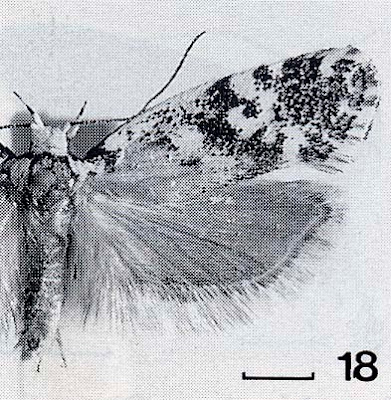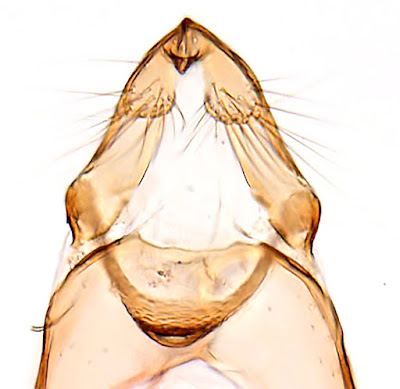Lichenaula lichenea Meyrick, 1890
Lichenaula lichenea, QM
Lichenaula lichenea, ANIC
Lichenaula lichenea Meyrick, 1890. Descriptions of Australian Lepidoptera. Part I. Xyloryctidae. Transactions of the Royal Society of South Australia 13: 23–81 [49]. Syntype(s) BMNH number unknown ♂♀, Sydney, Bathurst and Cooma, NSW; Melbourne, Vic.
Lichenaula lichenea Meyr. Lower, 1896: A catalogue of Victorian Heterocera. Part xix. The Victorian Naturalist, 12: 149-152 [150].
Lichenaula lichenea Meyr. Turner, 1898. The Xyloryctidae of Queensland. Annals of the Queensland Museum 4: 1–32 [19].
Lichenaula lichenaea Meyr. Lower, 1917, The Lepidoptera of Broken Hill, New South Wales. Part III. Transactions of the Royal Society of South Australia, 41, 369-477 [370].
Lichenaula lichenea Meyr. Philpott, 1927: The Maxillae in the Lepidoptera. Transactions and Proceedings of the Royal Society of New Zealand, Vol. 57, 721-745 [736].
Phthonerodes lichenea M. senior synonym of P. undulatella, Wlk. Fletcher, T. B., 1929, A list of generic names used for Microlepidoptera. Memoirs of the Department of Agriculture of India, 11: 1-244 [126].
Lichenaula lichenea Meyr. Common, 1963, Australian Moths, Jacaranda Press, 1-128 (50-54) [52-53, fig 107].
Lichenaula lichenea Meyr. Common, 1970: Lepidoptera (Moths and Butterflies), The Insects of Australia, Melbourne University Press, 765-866 [824].
Lichenaula lichenea Meyr. Common, 1990, Moths of Australia, Melbourne University Press. 227-230 [227].
Lichenaula lichenea Meyrick, 1890. Common, in Nielsen, Edwards, & Rangsi, 1996, Checklist of the Lepidoptera of Australia. Monographs on Australian Lepidoptera, 4: i-xiv, 1-529 & CD-ROM [87].
Lichenaula lichenea Meyrick, 1890. Beccaloni, G. W., Scoble, M. J., Robinson, G. S. & Pitkin, B. (Editors). 2003. The Global Lepidoptera Names Index (LepIndex). World Wide Web electronic publication. Lepindex [accessed 16 September 2018].
Lichenaula lichenea Meyrick, 1890. Edwards, E. D. (2003), Xyloryctinae. Australian Faunal Directory. Australian Biological Resources Study, Canberra. http://www.environment.gov.au/biodiversity/abrs/online-resources/fauna/afd/taxa/XYLORYCTINAE [accessed 18 June 2010].
Original description, Meyrick 1890
Lich. lichenea, n. sp.
Both sexes 15-21 mm. Head white. Palpi white, base of second joint, and base and apex of terminal joint blackish. Antennae white, annulated with blackish, ciliations in male 1. Thorax white, sprinkled with-black, and with a black transverse anterior spot on back. Abdomen grey or grey-whitish. Legs white, anterior and middle pair banded with blackish. Forewings elongate, costa gently arched, apex rounded, hind margin very obliquely rounded; 7 to apex or near below it; ochreous-white, with some scattered black scales; markings brown or grey, densely irrorated with black; a slender irregular oblique fascia near base, generally more or less broadly dilated on lower half; a moderate irregular spot on middle of inner margin; a dot in disc at ½; a small spot in middle of disc, and a furcate mark on inner margin before anal angle, both often much enlarged and suffused so as to become confluent into a cloudy irregular fascia, connecting above with a small spot on costa beyond middle, whence proceeds an irregular somewhat outwards-curved transverse line, sometimes interrupted in disc, to rejoin ante-anal spot of inner margin; often a separate dot within enclosed space; two marks on costa towards apex; a suffused more or less developed subapical spot; a slender streak along hindmargin; all these markings very variable in size and suffusion: cilia ochreous-white, barred with grey, bars densely irrorated with black on basal half. Hindwings varying from rather dark grey to pale whitish-grey; cilia whitish, with a grey line.
Sydney, Bathurst (2,500 feet), and Cooma (3,000 feet), New South Wales; Melbourne, Victoria; common from November to April, at rest on fences and rocks. Larva 16-legged, moderate, cylindrical, with rather long scattered whitish hairs; grey; dorsal, subdorsal, lateral, and spiracular lines dark grey, irregular: spots moderate, black; head blackish; second segment whitish-grey, with a blackish divided plate; anal segment blackish: feeds on lichen-dust on fences and rocks, forming a tunnel in a crevice for shelter, and feeding beneath a gallery of web and refuse, in August and September. The species is a very variable one, and the varieties show some tendency to be localised.
Other references
L. lichenea, Meyr. (loc. cit., 49, 1889).
Melbourne. (Lower, 1896).
Lichenaula lichenea, Meyr. Meyrick, 49. Common among the granite rocks at Ballandean (2,500 feet). near Wallangarra. (Turner, 1898).
LICHENAULA LICHENAEA, Meyr.
Not uncommon, March and April. (Lower, 1917).
Crypt. Lichenaula Meyrick 1890 (PHTHONERODES, Meyr.)
T. R. Soc.S. Autr. XIII 46: type [undulatella Wlk. = lichenea M. [E. Australia]. (Fletcher, 1929).
Lichenaula lichenea, fig. 107, Common 1963.
Among the smaller species, some such as Lichenaula lichenea Meyr. (107, male 0.9 inch) feed amongst lichens on tree trunks. (Common, 1963).
The larvae of some, such as L. choriodes Meyr. (Fig 36.32C) and L. lichenea Meyr., feed upon lichens growing on fences and rocks, sheltering in a gallery of silk and refuse particles. (Common, 1970).
Fig 22.18: Lichenaula lichenea
The larvae of some, such as L. lichenea Meyr. (Fig 22.18) feed on lichens, sheltering in a tube constructed of silk and lichen fragments in a crevice in a dead tree trunk, wooden fence or rock and browsing beneath webbing on the lichens growing on the surface. The wing pattern of L. lichenea matches the lichens amongst which it rests. The species is distributed from southern Queensland to southern New South Wales and, no doubt, Victoria. (Common, 1990).
Diagnosis:
Description:
Head:
Thorax:
Abdomen:
Lichenaula lichenea,♂genitalia. Cronulla, NSW, 28 February 1952, collected by I.F.B. Common.
ANIC slide no. G272, dissected by I.F.B. Common, 1959. Photomicrograph taken at ANIC, Canberra.
Lichenaula lichenea, clasper. ANIC slide no. G272.
Lichenaula lichenea, uncus and gnathos. ANIC slide no. G272.
Lichenaula lichenea, anellus, saccus and juxta. ANIC slide no. G272.
Food plants: Larva in silk gallery in crevice. Larval foodplant: lichen. (Edwards, 2003).
Flight period: February, March, April.
Distribution: Australian Capital Territory, New South Wales, Queensland. Endemic. (Edwards, 2003).
Remarks:
Updated 19 September 2019








